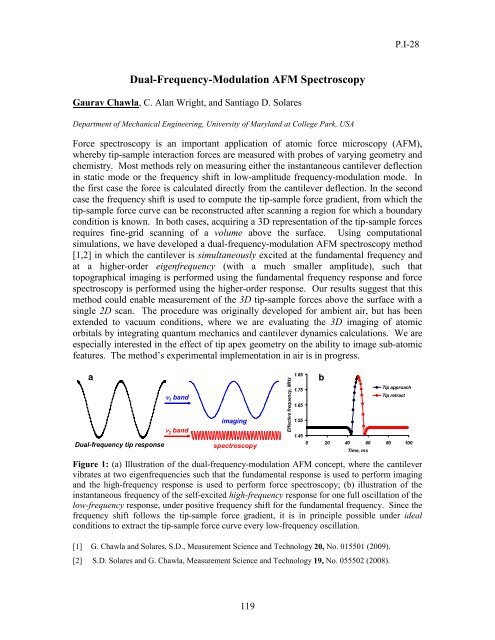Noncontact Atomic Force Microscopy - Yale School of Engineering ...
Noncontact Atomic Force Microscopy - Yale School of Engineering ...
Noncontact Atomic Force Microscopy - Yale School of Engineering ...
Create successful ePaper yourself
Turn your PDF publications into a flip-book with our unique Google optimized e-Paper software.
Dual-Frequency-Modulation AFM Spectroscopy<br />
Gaurav Chawla, C. Alan Wright, and Santiago D. Solares<br />
Department <strong>of</strong> Mechanical <strong>Engineering</strong>, University <strong>of</strong> Maryland at College Park, USA<br />
P.I-28<br />
<strong>Force</strong> spectroscopy is an important application <strong>of</strong> atomic force microscopy (AFM),<br />
whereby tip-sample interaction forces are measured with probes <strong>of</strong> varying geometry and<br />
chemistry. Most methods rely on measuring either the instantaneous cantilever deflection<br />
in static mode or the frequency shift in low-amplitude frequency-modulation mode. In<br />
the first case the force is calculated directly from the cantilever deflection. In the second<br />
case the frequency shift is used to compute the tip-sample force gradient, from which the<br />
tip-sample force curve can be reconstructed after scanning a region for which a boundary<br />
condition is known. In both cases, acquiring a 3D representation <strong>of</strong> the tip-sample forces<br />
requires fine-grid scanning <strong>of</strong> a volume above the surface. Using computational<br />
simulations, we have developed a dual-frequency-modulation AFM spectroscopy method<br />
[1,2] in which the cantilever is simultaneously excited at the fundamental frequency and<br />
at a higher-order eigenfrequency (with a much smaller amplitude), such that<br />
topographical imaging is performed using the fundamental frequency response and force<br />
spectroscopy is performed using the higher-order response. Our results suggest that this<br />
method could enable measurement <strong>of</strong> the 3D tip-sample forces above the surface with a<br />
single 2D scan. The procedure was originally developed for ambient air, but has been<br />
extended to vacuum conditions, where we are evaluating the 3D imaging <strong>of</strong> atomic<br />
orbitals by integrating quantum mechanics and cantilever dynamics calculations. We are<br />
especially interested in the effect <strong>of</strong> tip apex geometry on the ability to image sub-atomic<br />
features. The method’s experimental implementation in air is in progress.<br />
1.85<br />
a b<br />
Dual-frequency tip response<br />
ν 1 band<br />
ν 2 band<br />
imaging<br />
spectroscopy<br />
Effective frequency, MHz<br />
1.75<br />
1.65<br />
1.55<br />
1.45<br />
0 20 40 60 80 100<br />
Time, ms<br />
Tip approach<br />
Tip retract<br />
Figure 1: (a) Illustration <strong>of</strong> the dual-frequency-modulation AFM concept, where the cantilever<br />
vibrates at two eigenfrequencies such that the fundamental response is used to perform imaging<br />
and the high-frequency response is used to perform force spectroscopy; (b) illustration <strong>of</strong> the<br />
instantaneous frequency <strong>of</strong> the self-excited high-frequency response for one full oscillation <strong>of</strong> the<br />
low-frequency response, under positive frequency shift for the fundamental frequency. Since the<br />
frequency shift follows the tip-sample force gradient, it is in principle possible under ideal<br />
conditions to extract the tip-sample force curve every low-frequency oscillation.<br />
[1] G. Chawla and Solares, S.D., Measurement Science and Technology 20, No. 015501 (2009).<br />
[2] S.D. Solares and G. Chawla, Measurement Science and Technology 19, No. 055502 (2008).<br />
119















